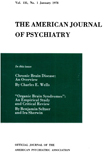TEMPORARY INSANITY AS A DEFENSE
Abstract
It is not necessary to argue the point that transitory psychoses occur, and are seen frequently by the clinician. Occasionally a crime is committed during such a state— sometimes referred to as an acute psychotic episode. We must establish a set of criteria for the clinical diagnosis of the condition when it exists or is alleged to have existed, and these, we feel, will suffice for purposes of defense. We here quote Overholser (4) who quotes Isaac Ray,
Insanity (the word was used then by medical men as equivalent with "psychosis"), is a disease, and as is the case with all other diseases, the fact of its existence is never established by a single diagnostic symptom, but by the whole body of symptoms, no particular one of which is present in every case.
The Ray awards of the A.P.A. have in recent years resulted in a growing body of knowledge, most helpful to forensic psychiatry. We have already alluded to Overholser's award book "The Psychiatrist and the Law." Another of these miniature classics is the one by Zilboorg(5). The second winner of the Ray award, frequently humorous, at times bitterly critical, is none the less clinical in his observations. Concerning the M'Naghten rule, he says, "It is the monster of the earnest psychiatrist which prevents him from introducing into the courtroom true understanding of human psychology and of the criminal act." In the Brannen case in Queens County, State of New York, a psychiatrist was asked the question, "What is psychosis ?" and instead of being limited to a brief answer was permitted to go up in front of the jury box and with pencil and paper explain schematically the relationship between quantity of ego functioning and psychosis. This was made possible by a team of competent defense lawyers, and even more important, an alert, curious and tolerant judge. One wonders whether Judge Farrell was even interested in adding to medico-legal history when he agreed that the psychiatrist may use diagrams in clarifying his clinical points. Later, the same lawyers and in the same case, further attacked the status quo when they were successful in a habeas corpus writ and obtained Brannen's release from Matteawan without referral to the court of orginal jurisdiction.
The Brannen case alone could have been an interesting presentation. We chose to include other clinical material because we desire a discussion of the broader aspects of temporary insanity as a defense. Acute psychotic episodes, or transitory psychotic states, or temporary insanity are terms depicting the same clinical entity. A person in such state manifests in behavior and expresses n words evidence of marked diminution of ego functioning. This may result in disturbance of thinking, perception, and judgment to such severe degree as to make it impossible for the affected person to distinguish reality from unreality.
Access content
To read the fulltext, please use one of the options below to sign in or purchase access.- Personal login
- Institutional Login
- Sign in via OpenAthens
- Register for access
-
Please login/register if you wish to pair your device and check access availability.
Not a subscriber?
PsychiatryOnline subscription options offer access to the DSM-5 library, books, journals, CME, and patient resources. This all-in-one virtual library provides psychiatrists and mental health professionals with key resources for diagnosis, treatment, research, and professional development.
Need more help? PsychiatryOnline Customer Service may be reached by emailing [email protected] or by calling 800-368-5777 (in the U.S.) or 703-907-7322 (outside the U.S.).



